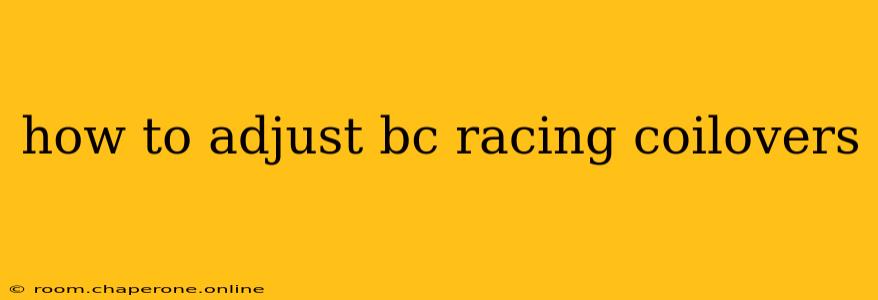BC Racing coilovers offer a significant upgrade to your vehicle's handling and ride quality, allowing for precise adjustments to suit your driving style and preferences. However, understanding how to properly adjust these coilovers is crucial to maximizing their performance and ensuring a safe driving experience. This guide will walk you through the process step-by-step.
Understanding BC Racing Coilover Components
Before diving into adjustments, let's familiarize ourselves with the key components:
- Ride Height Adjustment: This controls the overall height of your vehicle. It's usually achieved by turning a threaded collar on the shock body.
- Damping Adjustment: This controls the shock's resistance to compression and rebound. BC Racing coilovers typically have separate adjustments for compression and rebound, offering fine-tuned control. These adjustments are often made via a dial or clicker on the shock body.
- Spring Preload: This refers to the tension on the spring before the suspension is compressed. While not directly adjusted on all BC Racing models, it influences ride height and can be indirectly adjusted by changing the ride height.
Step-by-Step Adjustment Guide
Always consult your specific BC Racing coilover instruction manual for detailed diagrams and specifications for your model. The following is a general guide; variations may exist.
1. Preparing for Adjustment
- Safety First: Park your vehicle on a level surface, engage the parking brake, and chock the wheels. Use jack stands to securely lift your vehicle. Never work under a vehicle supported only by a jack.
- Gather Tools: You'll typically need a wrench or socket to adjust the ride height and a screwdriver or spanner for damping adjustments, depending on your model. A measuring tape can also be helpful for consistent adjustments.
- Clean the Area: Clean the areas around the coilovers to prevent dirt and debris from interfering with adjustments.
2. Ride Height Adjustment
- Locate the Threaded Collar: Identify the threaded collar on the shock body. This is usually located near the top of the shock.
- Adjust the Collar: Turning the collar clockwise will lower the ride height, while counter-clockwise will raise it. Make small adjustments and check the change in ride height frequently. Use a measuring tape for consistency.
- Even Adjustments: Ensure you make symmetrical adjustments to both sides of the vehicle to maintain proper alignment.
3. Damping Adjustment
- Locate the Damping Adjusters: These are usually dials or clickers located on the shock body. Each will control either compression or rebound damping.
- Compression Damping: Adjusting compression damping affects how quickly the shock compresses when encountering bumps. Higher numbers typically indicate firmer compression.
- Rebound Damping: Adjusting rebound damping affects how quickly the shock extends after compression. Higher numbers indicate slower rebound.
- Adjustments: Typically, you'll start with the manufacturer's recommended settings and then fine-tune based on your preferences. Small adjustments are best; make one change at a time to understand its effect.
4. Testing and Fine-tuning
- Test Drive: After making adjustments, take your vehicle for a test drive on various road surfaces.
- Iterative Process: Fine-tune your settings based on your driving experience. You may find that you need to adjust both ride height and damping to achieve your desired balance between comfort and performance.
Understanding Damping Effects
The effects of damping adjustments are subtle but significant. Consider these factors when tuning:
- Increased Compression Damping: Leads to a firmer, less bouncy ride, improving handling but potentially sacrificing comfort.
- Decreased Compression Damping: Leads to a softer, more comfortable ride but potentially compromises handling at higher speeds.
- Increased Rebound Damping: Leads to a more controlled and stable ride, reducing body roll and improving handling, but potentially feeling stiffer.
- Decreased Rebound Damping: Leads to a softer, more compliant ride, but can increase body roll and make the car feel less stable.
Final Thoughts
Adjusting BC Racing coilovers is a rewarding process that allows for a personalized driving experience. Remember to always prioritize safety, consult your instruction manual, and make small, incremental adjustments to achieve optimal settings. With patience and practice, you'll be able to fine-tune your coilovers to perfectly match your driving style and the conditions you frequently encounter.

